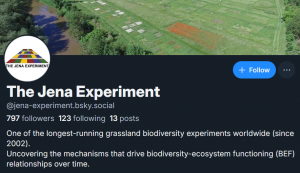New publication from Lange et al. in Global Change Biology: Increased soil carbon storage through plant diversity strengthens with time and extends into the subsoil
Soils are important for ecosystem functioning and service provisioning. Soil communities and their functions, in turn, are strongly promoted by plant diversity, and such positive effects strengthen with time. However, plant diversity effects on soil organic matter have mostly been investigated in the topsoil, and there are only very few long-term studies. Thus, it remains unclear if plant diversity effects strengthen with time and to which depth these effects extend. Here, we repeatedly sampled soil to 1 m depth in a long-term grassland biodiversity experiment. We investigated how plant diversity impacted soil organic carbon and nitrogen concentrations and stocks and their stable isotopes 13C and 15N, as well as how these effects changed after 5, 10, and 14 years. We found that higher plant diversity increased carbon and nitrogen storage in the topsoil since the establishment of the experiment. Stable isotopes revealed that these increases were associated with new plant-derived inputs, resulting in less processed and less decomposed soil organic matter. In subsoils, mainly the presence of specific plant functional groups drove organic matter dynamics. For example, the presence of deep-rooting tall herbs decreased carbon concentrations, most probably through stimulating soil organic matter decomposition. Moreover, plant diversity effects on soil organic matter became stronger in topsoil over time and reached subsoil layers, while the effects of specific plant functional groups in subsoil progressively diminished over time. Our results indicate that after changing the soil system the pathways of organic matter transfer to the subsoil need time to establish. In our grassland system, organic matter storage in subsoils was driven by the redistribution of already stored soil organic matter from the topsoil to deeper soil layers, for example, via bioturbation or dissolved organic matter. Therefore, managing plant diversity may, thus, have significant implications for subsoil carbon storage and other critical ecosystem services.

Reference:
Lange, M., Eisenhauer, N., Chen, H., & Gleixner, G. (2023). Increased soil carbon storage through plant diversity strengthens with time and extends into the subsoil. Global Change Biology, 00, 1– 13. https://doi.org/10.1111/gcb.16641



